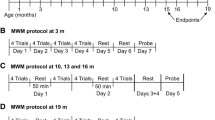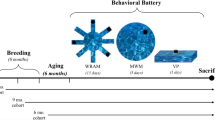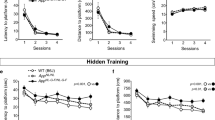Abstract
Neuroinflammation and behavioural inflexibility are both common in late adulthood but far more profound in Alzheimer disease (AD). To investigate the relationship between ageing, AD, neuroinflammation, and behavioural flexibility, male wild-type Fischer 344 (Wt) and the transgenic APP21 (TgAPP21) rats were aged to 4, 8, 13, and 22 months and evaluated for neuroinflammation and cognitive impairment. TgAPP21 rats overexpress a pathogenic variant of the human amyloid precursor protein (hAPP; Swedish and Indiana mutations) but do not spontaneously develop overt pathology related to AD. In both genotypes, learning and memory were similarly impaired in older rats. However, at 8 months of age, TgAPP21 rats demonstrated behavioural inflexibility in set shifting, reversal, and the Morris water maze, while Wt rats showed inflexibility at 13 and 22 months of age. This early inflexibility in TgAPP21 rats was accompanied by a precocious increase in microglia activation within the corpus callosum; 8- and 13-month-old TgAPP21 rats had similar levels of microglia activation as 13- and 22-month-old Wt rats, respectively. However, while neuroinflammation within the white matter continued to progress with age, behavioural inflexibility peaked in 8-month-old TgAPP21 rats; in older TgAPP21 rats, memory and learning impairments masked inflexibility. These findings suggest that the behavioural inflexibility and white matter inflammation seen in normal ageing are accelerated in AD and may precede impairments of learning and memory.









Similar content being viewed by others
Data Availability
The datasets generated and analysed for the current study are available from the corresponding author on a reasonable request.
Code Availability
Not applicable.
References
Johnson JK, Lui LY, Yaffe K (2007) Executive function, more than global cognition, predicts functional decline and mortality in elderly women. J Gerontol - Ser A Biol Sci Med Sci 62:1134–1141. https://doi.org/10.1093/gerona/62.10.1134
Diamond A (2013) Executive functions. Annu Rev Psychol 64:135–141. https://doi.org/10.1146/annurev-psych-113011-143750
Harada CN, Natelson Love MC, Triebel KL (2013) Normal cognitive aging. Clin Geriatr Med 29:737–752. https://doi.org/10.1016/j.cger.2013.07.002
Grieve SM, Williams LM, Paul RH et al (2007) Cognitive aging, executive function, and fractional anisotropy: a diffusion tensor MR imaging study. Am J Neuroradiol 28:226–235
Hedden T, Gabrieli JDE (2004) Insights into the ageing mind: a view from cognitive neuroscience. Nat Rev Neurosci 5:87–96. https://doi.org/10.1038/nrn1323
Rabin JS, Perea RD, Buckley RF et al (2018) Global white matter diffusion characteristics predict longitudinal cognitive change independently of amyloid status in clinically normal older adults. Cereb Cortex 29:1251–1262. https://doi.org/10.1093/cercor/bhy031
Sasson E, Doniger GM, Pasternak O et al (2013) White matter correlates of cognitive domains in normal aging with diffusion tensor imaging. Front Neurosci 7:1–13. https://doi.org/10.3389/fnins.2013.00032
Gunning-Dixon FM, Raz N (2000) The cognitive correlates of white matter abnormalities in normal aging: a quantitative review. Neuropsychology 14:224–232. https://doi.org/10.1037/0894-4105.14.2.224
Guttmann CR, Jolesz FA, Kikinis R et al (1998) White matter changes with normal aging. Neurology. https://doi.org/10.1212/WNL.50.4.972
Fowler JH, McQueen J, Holland PR et al (2018) Dimethyl fumarate improves white matter function following severe hypoperfusion: involvement of microglia/macrophages and inflammatory mediators. J Cereb Blood Flow Metab 38:1354–1370. https://doi.org/10.1177/0271678X17713105
Hase Y, Horsburgh K, Ihara M, Kalaria RN (2018) White matter degeneration in vascular and other ageing-related dementias. J Neurochem 144:617–633. https://doi.org/10.1111/jnc.14271
Lan LF, Zheng L, Yang X et al (2015) Peroxisome proliferator-activated receptor-γ agonist pioglitazone ameliorates white matter lesion and cognitive impairment in hypertensive rats. CNS Neurosci Ther 21:410–416. https://doi.org/10.1111/cns.12374
Manso Y, Holland PR, Kitamura A et al (2018) Minocycline reduces microgliosis and improves subcortical white matter function in a model of cerebral vascular disease. Glia 66:34–46. https://doi.org/10.1002/glia.23190
Miyanohara J, Kakae M, Nagayasu K, et al (2018) TRPM2 channel aggravates CNS inflammation and cognitive impairment via activation of microglia in chronic cerebral hypoperfusion. J Neurosci 2451–17.https://doi.org/10.1523/JNEUROSCI.2451-17.2018
Qin C, Fan WH, Liu Q et al (2017) Fingolimod protects against ischemic white matter damage by modulating microglia toward M2 polarization via STAT3 pathway. Stroke 48:3336–3346. https://doi.org/10.1161/STROKEAHA.117.018505
Shobin E, Bowley MP, Estrada LI et al (2017) Microglia activation and phagocytosis: relationship with aging and cognitive impairment in the rhesus monkey. GeroScience 39:199–220. https://doi.org/10.1007/s11357-017-9965-y
Wolf G, Lotan A, Lifschytz T et al (2017) Differentially severe cognitive effects of compromised cerebral blood flow in aged mice: association with myelin degradation and microglia activation. Front Aging Neurosci 9:191. https://doi.org/10.3389/fnagi.2017.00191
Streit WJ, Xue Q-S, Tischer J, Bechmann I (2014) Microglial pathology. Acta Neuropathol Commun 2:142. https://doi.org/10.1186/s40478-014-0142-6
Raj D, Yin Z, Breur M et al (2017) Increased white matter inflammation in aging- and Alzheimer’s disease brain. Front Mol Neurosci 10:1–18. https://doi.org/10.3389/fnmol.2017.00206
Jansen WJ, Ossenkoppele R, Knol DL et al (2015) Prevalence of cerebral amyloid pathology in persons without dementia. JAMA 313:1924. https://doi.org/10.1001/jama.2015.4668
Prokop S, Miller KR, Heppner FL (2013) Microglia actions in Alzheimer’s disease. Acta Neuropathol 126:461–477
von Bernhardi R, Eugenín-von Bernhardi L, Eugenín J (2015) Microglial cell dysregulation in brain aging and neurodegeneration. Front Aging Neurosci 7
Sudduth TL, Schmitt FA, Nelson PT, Wilcock DM (2013) Neuroinflammatory phenotype in early Alzheimer’s disease. Neurobiol Aging 34:1051–1059. https://doi.org/10.1016/j.neurobiolaging.2012.09.012
Lee S, Viqar F, Zimmerman ME et al (2016) White matter hyperintensities are a core feature of Alzheimer’s disease: evidence from the dominantly inherited Alzheimer network. Ann Neurol 79:929–939. https://doi.org/10.1002/ana.24647
Maier-Hein KH, Westin CF, Shenton ME et al (2015) Widespread white matter degeneration preceding the onset of dementia. Alzheimer’s Dement 11:485-493.e2. https://doi.org/10.1016/j.jalz.2014.04.518
Baudic S, Barba GD, Thibaudet MC et al (2006) Executive function deficits in early Alzheimer’s disease and their relations with episodic memory. Arch Clin Neuropsychol 21:15–21. https://doi.org/10.1016/j.acn.2005.07.002
Belleville S, Fouquet C, Duchesne S et al (2014) Detecting early preclinical alzheimer’s disease via cognition, neuropsychiatry, and neuroimaging: qualitative review and recommendations for testing. J Alzheimer’s Dis 42:S375–S382
Fabrigoule C, Rouch I, Taberly A et al (1998) Cognitive process in preclinical phase of dementia. Brain 121:135–141. https://doi.org/10.1093/brain/121.1.135
Grober E, Hall CB, Lipton RB et al (2008) Memory impairment, executive dysfunction, and intellectual decline in preclinical Alzheimer’s disease. J Int Neuropsychol Soc 14:266–278. https://doi.org/10.1017/S1355617708080302
Agca C, Fritz JJ, Walker LC et al (2008) Development of transgenic rats producing human β-amyloid precursor protein as a model for Alzheimer’s disease: transgene and endogenous APP genes are regulated tissue-specifically. BMC Neurosci 9:28. https://doi.org/10.1186/1471-2202-9-28
Rosen RF, Fritz JJ, Dooyema J et al (2012) Exogenous seeding of cerebral beta-amyloid deposition in betaAPP-transgenic rats. J Neurochem 120:660–666. https://doi.org/10.1111/j.1471-4159.2011.07551.x
Silverberg GD, Miller MC, Pascale CL et al (2015) Kaolin-induced chronic hydrocephalus accelerates amyloid deposition and vascular disease in transgenic rats expressing high levels of human APP. Fluids Barriers CNS 12:2. https://doi.org/10.1186/2045-8118-12-2
Levit A, Regis AM, Garabon JR et al (2017) Behavioural inflexibility in a comorbid rat model of striatal ischemic injury and mutant hAPP overexpression. Behav Brain Res 333:267–275. https://doi.org/10.1016/j.bbr.2017.07.006
Levit A, Regis AMAM, Gibson A et al (2019) Impaired behavioural flexibility related to white matter microgliosis in the TgAPP21 rat model of Alzheimer disease. Brain Behav Immun 80:25–34. https://doi.org/10.1016/j.bbi.2019.02.013
Floresco SB, Block AE, Tse MTL (2008) Inactivation of the medial prefrontal cortex of the rat impairs strategy set-shifting, but not reversal learning, using a novel, automated procedure. Behav Brain Res 190:85–96. https://doi.org/10.1016/j.bbr.2008.02.008
Brady AM, Floresco SB (2015) Operant procedures for assessing behavioral flexibility in rats. J Vis Exp e52387. https://doi.org/10.3791/52387
Roof RL, Schielke GP, Ren X, Hall ED (2001) A comparison of long-term functional outcome after 2 middle cerebral artery occlusion models in rats. Stroke 32:2648–2657
Wong WT (2013) Microglial aging in the healthy CNS: phenotypes, drivers, and rejuvenation. Front Cell Neurosci 7. https://doi.org/10.3389/fncel.2013.00022
Sofroniew MV, Vinters HV (2010) Astrocytes: biology and pathology. Acta Neuropathol 119:7–35. https://doi.org/10.1007/s00401-009-0619-8
Paxinos G, Watson C (2007) The rat brain in stereotaxic coordinates, 6th edn. Academic Press/Elsevier, , Amsterdam
Caughlin S, Maheshwari S, Agca Y et al (2018) Membrane-lipid homeostasis in a prodromal rat model of Alzheimer’s disease: characteristic profiles in ganglioside distributions during aging detected using MALDI imaging mass spectrometry. Biochim Biophys Acta - Gen Subj 1862:1327–1338. https://doi.org/10.1016/J.BBAGEN.2018.03.011
Motulsky HJ, Brown RE (2006) Detecting outliers when fitting data with nonlinear regression—a new method based on robust nonlinear regression and the false discovery rate. BMC Bioinformatics 7:123. https://doi.org/10.1186/1471-2105-7-123
Head D, Buckner RL, Shimony JS et al (2004) Differential vulnerability of anterior white matter in nondemented aging with minimal acceleration in dementia of the alzheimer type: evidence from diffusion tensor imaging. Cereb Cortex 14:410–423. https://doi.org/10.1093/cercor/bhh003
Marco EJ, Harrell KM, Brown WS et al (2012) Processing speed delays contribute to executive function deficits in individuals with agenesis of the corpus callosum. J Int Neuropsychol Soc 18:521–529. https://doi.org/10.1017/S1355617712000045
Papathanasiou A, Messinis L, Zampakis P, Papathanasopoulos P (2017) Corpus callosum atrophy as a marker of clinically meaningful cognitive decline in secondary progressive multiple sclerosis. Impact on employment status. J Clin Neurosci 43:170–175. https://doi.org/10.1016/j.jocn.2017.05.032
Moreno MB, Concha L, González-Santos L et al (2014) Correlation between corpus callosum sub-segmental area and cognitive processes in school-age children. PLoS One 9:e104549. https://doi.org/10.1371/journal.pone.0104549
Treit S, Chen Z, Rasmussen C, Beaulieu C (2014) White matter correlates of cognitive inhibition during development: a diffusion tensor imaging study. Neuroscience 276:87–97. https://doi.org/10.1016/j.neuroscience.2013.12.019
Mamiya PC, Richards TL, Kuhl PK (2018) Right forceps minor and anterior thalamic radiation predict executive function skills in young bilingual adults. Front Psychol 9:118. https://doi.org/10.3389/fpsyg.2018.00118
Collins-Praino LE, Francis YI, Griffith EY et al (2014) Soluble amyloid beta levels are elevated in the white matter of Alzheimer’s patients, independent of cortical plaque severity. Acta Neuropathol Commun 2:1–10
Böttcher C, Schlickeiser S, Sneeboer MAM et al (2019) Human microglia regional heterogeneity and phenotypes determined by multiplexed single-cell mass cytometry. Nat Neurosci 22:78–90. https://doi.org/10.1038/s41593-018-0290-2
Masuda T, Sankowski R, Staszewski O, Prinz M (2020) Microglia heterogeneity in the single-cell era. Cell Rep 30:1271–1281
Tan YL, Yuan Y, Tian L (2020) Microglial regional heterogeneity and its role in the brain. Mol Psychiatry 25:351–367
Cohen J, Torres C (2019) Astrocyte senescence: evidence and significance. Aging Cell 18
Palmer AL, Ousman SS (2018) Astrocytes and aging. Front. Aging Neurosci 10
Lalonde R, Fukuchi K, Strazielle C (2012) APP transgenic mice for modelling behavioural and psychological symptoms of dementia (BPSD). Neurosci Biobehav Rev 36:1357–1375. https://doi.org/10.1016/j.neubiorev.2012.02.011
Toro CA, Zhang L, Cao J, Cai D (2019) Sex differences in Alzheimer’s disease—understanding the molecular impact. Brain Res 1719:194–207. https://doi.org/10.1016/j.brainres.2019.05.031
Guillot-Sestier M-V, Araiz AR, Mela V et al (2021) Microglial metabolism is a pivotal factor in sexual dimorphism in Alzheimer’s disease. Commun Biol 4:711. https://doi.org/10.1038/s42003-021-02259-y
Agca C, Klakotskaia D, Schachtman TR et al (2016) Presenilin 1 transgene addition to amyloid precursor protein overexpressing transgenic rats increases amyloid beta 42 levels and results in loss of memory retention. BMC Neurosci 17:46. https://doi.org/10.1186/s12868-016-0281-8
Acknowledgements
We would like to thank Dr. Lynn Wang, Shikhar Maheshwari, and UWO’s Animal Care and Veterinary Services staff for their technical assistance.
Funding
This work was supported in part by research grants from the Natural Sciences and Engineering Research Council of Canada to Brian L. Allman (435819) and to Shawn N. Whitehead (418489); the Canadian Consortium on Neurodegeneration in Aging, the Canadian Institutes of Health Research (126127), and the Canadian Foundation for Innovation (34213) to Shawn N. Whitehead.
Author information
Authors and Affiliations
Contributions
All authors contributed to the study conception and design. Material preparation, data collection, and analysis were performed by AL, AG, OH, and YJ. The first draft of the manuscript was written by AL and SNW and all authors commented on previous versions of the manuscript. All authors read and approved the final manuscript.
Corresponding author
Ethics declarations
Ethics Approval
Animal ethics and procedures were approved by the Animal Care Committee at Western University (protocol 2014–016) and are in compliance with Canadian and National Institute of Health Guides for the Care and Use of Laboratory Animals (NIH Publication #80–23).
Consent to Participate
Not applicable.
Consent for Publication
First author holds copyright to data and figures reproduced from dissertation submitted to the University of Western Ontario.
Competing Interests
The authors declare no competing interests.
Additional information
Publisher's Note
Springer Nature remains neutral with regard to jurisdictional claims in published maps and institutional affiliations.
Supplementary Information
Below is the link to the electronic supplementary material.
Rights and permissions
About this article
Cite this article
Levit, A., Gibson, A., Hough, O. et al. Precocious White Matter Inflammation and Behavioural Inflexibility Precede Learning and Memory Impairment in the TgAPP21 Rat Model of Alzheimer Disease. Mol Neurobiol 58, 5014–5030 (2021). https://doi.org/10.1007/s12035-021-02476-w
Received:
Accepted:
Published:
Issue Date:
DOI: https://doi.org/10.1007/s12035-021-02476-w




